First Storey
Rear Courtyard Topics
First Storey Topics
Yellow Dzambhala
Location Description
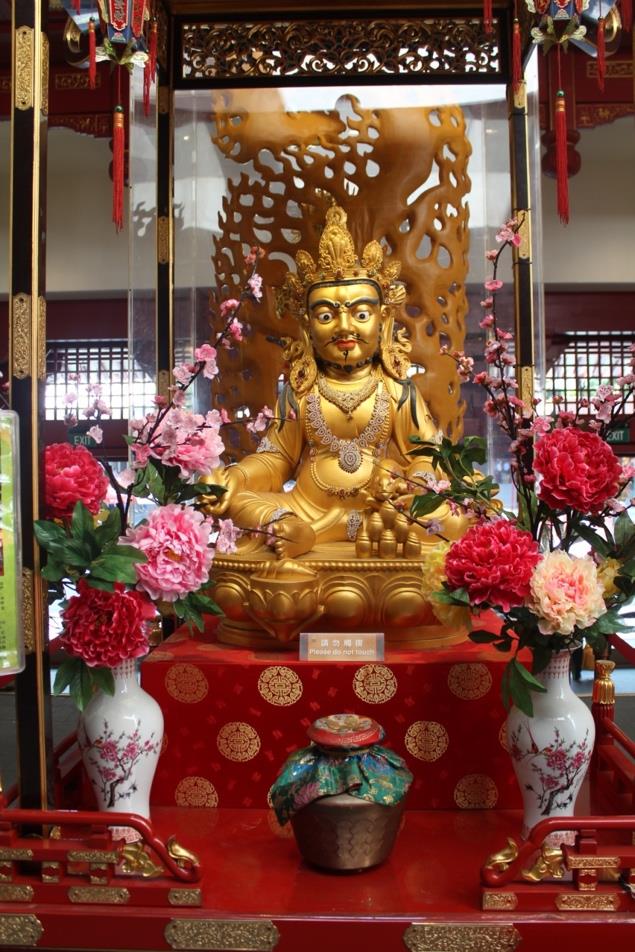
As you exit the Universal Wisdom Hall, towards the rear door of BTRTM, you will see the Yellow Dzambhala, enshrined on a special altar. Many devotees worship and pray to the Yellow Dzambhala for blessings.
About Yellow Dzambhala in BTRTM
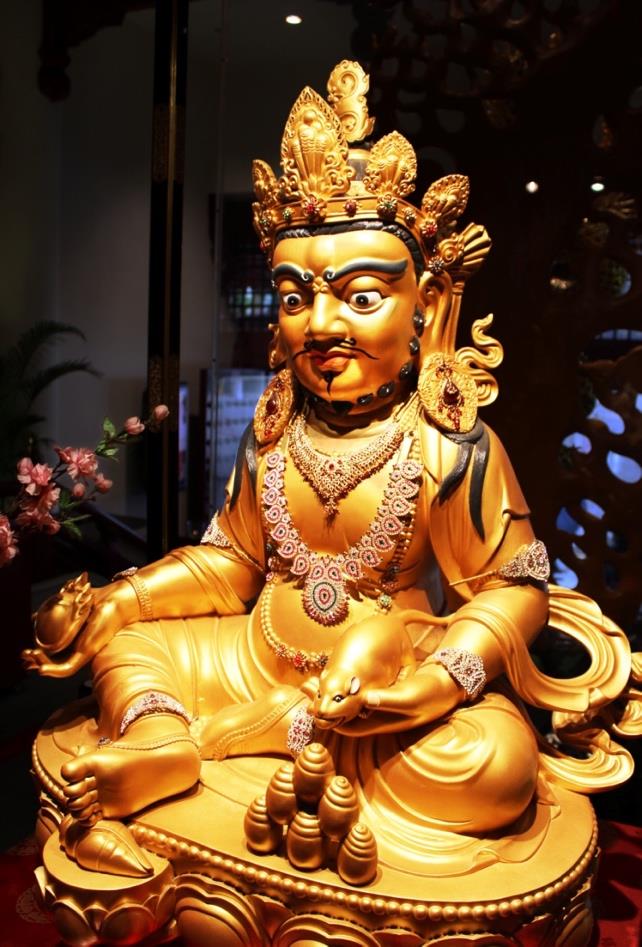
The Yellow Dzambhala has a big belly, a small body frame, strong arms and golden yellow skin. His right hand holds a precious "mani" citron fruit, whilst his left hand grasps a mongoose spouting jewels from its mouth.
He wears a 5-leaf crown just above his hairline and a headband of wish fulfilling jewels. He is clad in celestial costume for his lower body with heavenly ribbons draped around his upper naked body, adorned with blue lotus flowers and ornaments of various jewels, such as pearls and jade. His crown is secured by two straps: one around the back of his head and another around his topknot. With a bulging forehead, he sports a slender, curly moustache and goatee, long hair and a studded beard which frames the sides of his face starting from both his ears down to his chin. He looks angry and dignified with his thick knotted eyebrows and wide- open eyes gazing intently in front. He has long earlobes with big oval eye rings resting on his shoulders and he wears two thick ornate necklaces, anklets, bracelets and armbands.
With "upala" prayer beads hanging on his neck, he is seated in a relaxed and peaceful manner on a lotus pedestal with a moon disc. His left foot is folded and his right foot is stepping on a precious conch shell.
About Dzambhala
Yellow Dzambhala, (Sanskrit: Jambhala; Tibetan: Dzambala Tsepo, Zambala, ཛམ་བྷ་ལ་; Chinese: Yellow Wealth God), is one of the five Gods of Wealth who takes care of fortunes. He is also chief of the yaksas and is parallel to Pancika, Kubera and Vaisravana. Dzambhala is the kulesa or emanation of Buddha Ratnasambhava. He is able to help beings by getting rid of poverty, and leading them to abundance of wealth.
The Yellow Jambhala is considered the most popular and powerful of the Wealth Gods. He is the emanation of Buddha Ratnasambhava. He can remove poverty within the six realms, increase virtues, life span and wisdom.
He is also said to be an emanation of Vaisravana, one of the "Four Great World-protecting Heavenly Kings". He is the guardian of light in Buddhism, a great charitable deity who grants fortune and protection. Lord Vaisravana lives in the northern region under the Four Heavens, at the northern crystal palace on the fourth level of Mount Sumeru. His servants are either yaksas or bhaisajya-yaksas.
According to the commentary on Lotus Sutra, this heavenly king is extremely knowledgeable as his perpetual protection of the Buddhas has enabled him to receive many teachings.
Excerpt from: https://en.wikipedia.org/wiki/Jambhala - Yellow_Jambhala
It is said that there was a time at Grdhrakuta Mountain, when Buddha Shakyamuni was giving the teaching of Maha Prajna-paramita Sutra, some demons and maras came to interrupt by trying to shake and collapse the mountain, all at the scene were terrified. At such instance, Yellow Dzambhala manifested himself and protected all from the disaster. After which Buddha Shakyamuni entrusted Yellow Dzambhala to help all beings overcome poverty and to be the great dharma protector in future.
About Dharma
Yellow Dzambala is the foremost amongst the 5 Dzambalas (Wealth Deities). His main function is primarily to confer wealth on sentient beings so that they can have the financial resources required to lead a happy life.
A magnetizing practice, Yellow Dzambala practice helps its practitioners to be free from obstacles such as enemies, thieves, and illnesses and increases their material wealth, promotes spiritual wellbeing and be free from poverty.
If one is able to do this practice with the altruistic Bodhichitta motivation, to help all sentient beings to be free from poverty, one shall enjoy an unlimited supply of wealth and merits. For those who are constantly experiencing financial difficulties due to their negative karma from past life, Yellow Dzambala is undoubtedly their best source of support.
A person who follows the practice of Yellow Dzambala regularly shall be free from economic pressures and hardships. His or her fortune, life span, wisdom and all material and spiritual benefits shall also increase.
The Inner Wealth of Dharma
Buddha Shakyamuni emphasised the greater importance of spiritual over material wealth and encouraged His followers to moderate or even eliminate their desires for material wealth and resources. For example, in His own life story which was meant as a model for His disciples, He renounced the riches of His own kingdom in search of the path to full enlightenment. He also rejected King Bimbisara's offering of half of his huge kingdom.
Notwithstanding examples from His life story, He has also sacrificed his material wealth in many previous lives in the pursuit of the Dharma. In The Lotus Sutra, He explained that in a previous life as a king, He had forsaken material possessions and even His own body for the sake of receiving Dharma instructions which He viewed as more important than anything in the world:
Through innumerable eons in the past, I tirelessly sought the Dharma Flower Sutra. Throughout those many eons I was a king who vowed to seek an unexcelled awakening. Never faltering, and wanting to become fully developed in the six transcendental practices [paramitas (sanskrit) or Perfections], the king diligently and unstintingly gave alms—elephants, horses, the seven rare things, countries, cities, wives, children, male and female servants, attendants, and even his own head, eyes, marrow, brain, flesh, hands, and feet—not sparing his body or life.
—The Lotus Sutra, Chapter 12, paragraph 1
Material wealth, albeit is essential to sustain ourselves, is only of use to us in this life. We cannot take it to our future lives. If we spend much time and energy in accumulating wealth and resources, we will have little time left for Dharma practice. Moreover, if we are very wealthy, we would often face personal threats and become anxious. In order to protect, maintain and increase our wealth, we have to work extra hard, sometimes even having to resort to deceiving others.
However, if we devote ourselves wholeheartedly to the Dharma, even when we are poor, eventually—either in this or future lives—we will attain real Dharma jewels which is the only wealth we can carry with us. These are the true wealth of a pure practitioner.
Off all wealth, contentment is supreme,
Said he [Buddha] who taught and guided gods and men.
So always be content; if you know this
Yet have no wealth, true riches you’ll have found.
Kind Sir, to own a lot brings so much misery,
There’s no such grief for those with few desires.
—Nagarjuna, Letter to a Friend, verses 34-35
With the wealth of Dharma, even without much resources, we can be happy and benefit countless others, just like the great Tibetan meditator Milarepa (c.1052 – c.1135) who, following Buddha's example and realising that practising Dharma was singularly most important, spent most of his life in solitary retreats in the Himalayas. Even though he was materially destitute, he was undeterred and he finally attained the supreme wealth of Buddhahood in one short life.
Ultimately, Yellow Dzambala is a protector of our inner wealth of the Dharma. If we engage in his practice and devote ourselves to him sincerely and with strong faith, he will arrange sufficient external conditions for us so that we will have everything we need to practise. These may not necessarily correspond to what we think we need. We may not be wealthy but as our practice progresses, he will bestow his blessings upon our minds so that our true wealth—the inner Dharma realizations—do not degenerate but will always increase.
Mantra
"Om Jambhala Jalendraya Svaha" or
"Om Dzambhala Dzalim Dzaye Svaha"
About Art
The Aspects of Yellow Dzambala:
Body: Golden or Yellow, dwarfish, pot-bellied.
Appearance: One face, 2 arms, 2 feet. His face is gentlelooking, and he wears a Five-Buddhas Crown.
Clothing and Ornaments: Wears a heavenly robe, body is decorated with a garland of blue lotus flowers and adorned with all kinds of jewels and ornaments. In front of his chest hangs a set of Upala prayer beads.
Hand Implements: His right hand is in the gesture of giving and holds a wish fulfilling citron fruit, the fruit of the jambhara (jambhala, jambhira) tree (Blyxa octandra), the symbol of wealth and abundance. His left hand is gently carrying a mongoose spewing jewels from the jaws, symbolizing a bountiful and unlimited supply of jewels, wealth and auspiciousness. The mongoose is the enemy of the snake which is a symbol of greed or hatred; the ejection of jewels represents generosity.
Sitting Posture and Leg Rest: He sits on a lotus flower and moon disc in the lalitasana posture of royal ease, left leg drawn in and right leg lightly stepping on a precious conch shell. Sometimes shown to trample on Sankhamunda and Padmamunda.
His images are found from the 8th century onwards, in India, Indonesia, Tibet, Nepal, etc.
Development of BTRTM Yellow Dzambhala
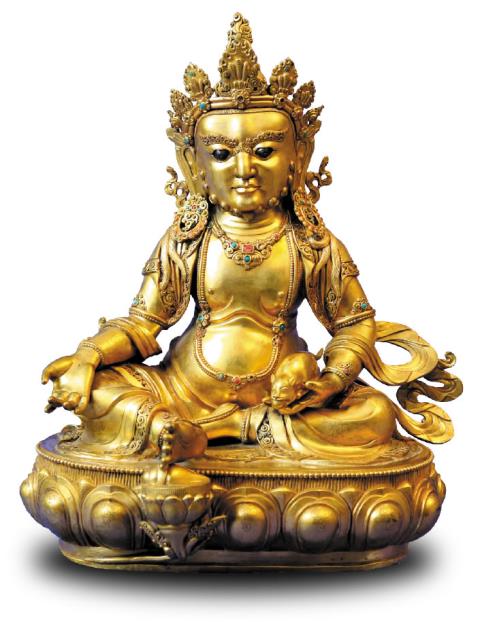
The BTRTM Yellow Dzambhala incorporates the features of this gilt bronze statue that belongs to our museum.
This specially carved wood statue is from Mr Zhan Weichen of Yueqing Global Arts and Crafts Factory of Zhejiang Province, China.
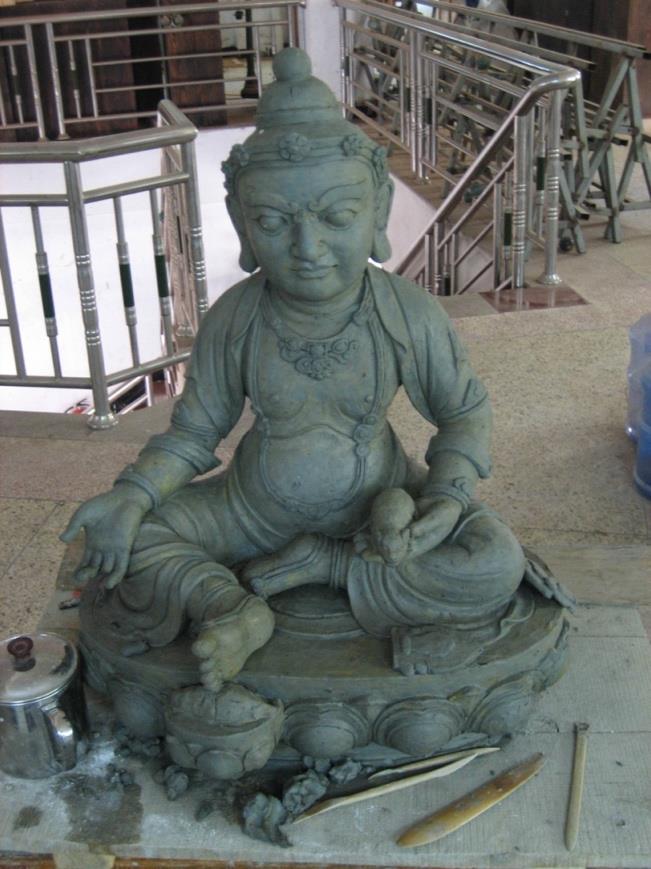
After the carving, it was then painted and decorated with jewellery, etc.
Dzambhala Wealth Vases
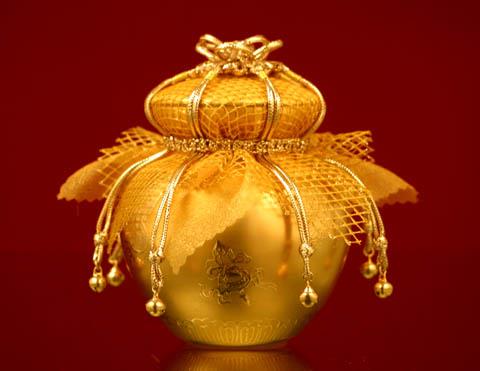
Our temple developed and produced the special Dzambhala wealth vases, as part of fund raising for its construction.
Bibliography:
Lokesh Chandra, Dictionary of Buddhist Iconography, International Academy of Indian Culture and Aditya Prakashan, 1999, Vol 5, pages 1500 - 1514 (Jambhala)
Louis Frederic, Buddhism, Flammarion Iconographic Guides, 1995, ISBN 2-08013-558-9, page 245
Meher McArthur, Reading Buddhist Art, An Illustrated Guide to Buddhist Signs & Symbols, Thames & Hudson,2002, pages 66 - 67
Charles F Chicarelli, Buddhist Art, An Illustrated Introduction, Silkworm Books, 2004, ISBN 974-9575-54-7, pages 209 -210
Robert E Fisher, Art of Tibet, Thames and Hudson, 1997, ISBN 0-500-20308-3, pages 118 - 122
Gene Reeves, The Lotus Sutra, Boston: Wisdom Publications, 2008, p. 247.